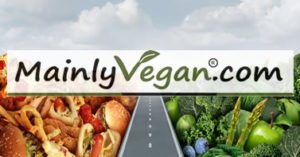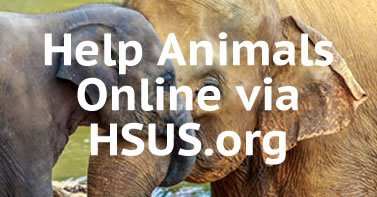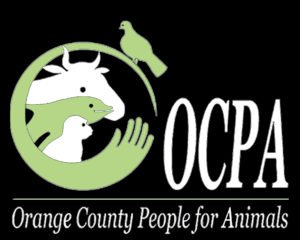In the U.S. alone, over a million farm animals are consumed every hour. And the multi-billion dollar business of factory farming wants the public to believe that animals are well treated before being killed for human consumption.
Nothing could be further from the truth: Cows, pigs, chickens, turkeys, sheep and other animals on factory farms are treated like machines with no regard whatsoever for their suffering.
And there are very few local, state or federal laws protecting these animals either throughout their short lives or during transport and slaughter.
Cattle for Beef
Accustomed to roaming unimpeded and unconstrained, range cattle are frightened and confused when humans come to round them up. Injuries often result as terrified animals are corralled and packed onto cattle trucks. Many will experience additional transportation and handling stress at stockyards and auctions where they are goaded through a series of walkways and holding pens and sold to the highest bidder. From the auction, older cattle may be taken directly to slaughter, or they may be taken to a feedlot. Younger animals, and breeding age cows, may go back to the range.
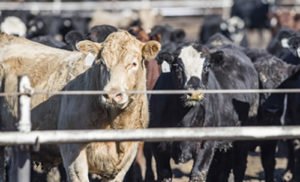 Most beef cattle spend the last few months of their lives at feedlots, crowded by the thousand into dusty, manure laden holding pens. The air is thick with harmful bacteria and particulate matter, and the animals are at a constant risk for respiratory disease. Feedlot cattle are routinely implanted with growth promoting hormones, and they are fed unnaturally rich diets designed to fatten them quickly and profitably. Because cattle are biologically suited to eat a grass-based, high fiber diet, their concentrated feedlot rations contribute to metabolic disorders.
Most beef cattle spend the last few months of their lives at feedlots, crowded by the thousand into dusty, manure laden holding pens. The air is thick with harmful bacteria and particulate matter, and the animals are at a constant risk for respiratory disease. Feedlot cattle are routinely implanted with growth promoting hormones, and they are fed unnaturally rich diets designed to fatten them quickly and profitably. Because cattle are biologically suited to eat a grass-based, high fiber diet, their concentrated feedlot rations contribute to metabolic disorders.
Young cattle are commonly taken to areas with cheap grazing land, to take advantage of this inexpensive feed source. Upon reaching maturity, they are trucked to a feedlot to be fattened and readied for slaughter. Eventually, all of them will end up at the slaughterhouse.
At a standard beef slaughterhouse, 250 cattle are killed every hour. As the assembly line speeds up, workers are rushed, and it becomes increasingly difficult to treat animals with any semblance of humaneness.
Cows for Dairy / Veal
All dairy cows must give birth in order to begin producing milk – and dairy cows are forced to have a calf every year. Like human beings, the cow’s gestation period is nine months long, and so giving birth every twelve months is physically demanding. The cows are also forced to give milk during seven months of their nine month pregnancy.
In a healthy environment, cows would live in excess of 25 years, but on modern dairies, they are slaughtered after just 3 or 4 years and then used for ground beef.
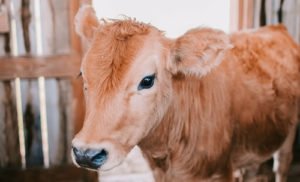 With genetic manipulation and intensive production technologies, it is common for modern dairy cows to produce 100 pounds of milk a day — ten times more than they would produce in nature. The cows’ bodies are under constant stress and they are at risk for numerous health problems.A cow eating a normal grass diet could not produce milk at the abnormal levels expected on modern dairies, and so today’s dairy cows must be given high energy feeds. The unnaturally rich diet causes metabolic disorders.
With genetic manipulation and intensive production technologies, it is common for modern dairy cows to produce 100 pounds of milk a day — ten times more than they would produce in nature. The cows’ bodies are under constant stress and they are at risk for numerous health problems.A cow eating a normal grass diet could not produce milk at the abnormal levels expected on modern dairies, and so today’s dairy cows must be given high energy feeds. The unnaturally rich diet causes metabolic disorders.
The veal industry was created as a by-product of the dairy industry to take advantage of an abundant supply of unwanted male calves.
Calves born to dairy cows are separated from their mothers immediately after birth and loaded onto trucks, causing great distress to both the baby and mother. Half of the dairy calves born are female, and they are raised to replace older dairy cows in the milking herd. The other half of the calves are male, and because they will never produce milk, they are raised and slaughtered for meat. Most are killed for beef, but about one million are used for veal. Many are sold through auction rings where they are subjected to transportation and handling stresses.
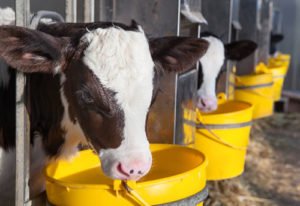
Veal calves live for up to sixteen weeks in small wooden crates and are chained by the neck to restrict all movement, so they cannot turn around, stretch their legs, or even lie down comfortably. The calves are fed a liquid milk substitute which is deficient in iron and fiber and designed to make the animals anemic. It is this anemia which results in the light colored flesh which is prized as veal.
Pigs are sociable, playful, and emotional animals with high intelligence level. And yet, approximately 100 million pigs are raised and slaughtered for food in the U.S. every year.
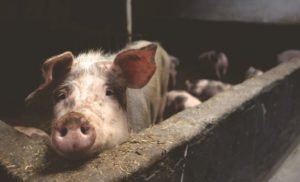
With corporate hog factories replacing traditional hog farms, pigs are being treated more as inanimate tools of production than as living, feeling animals.
Modern breeding sows are treated like piglet making machines. Living a continuous cycle of impregnation and birth, the sows each have more than 20 piglets per year. After being impregnated, the sows are confined in small pens or metal gestation crates which are just 2 feet wide. At the end of their 4 month pregnancy, they are transferred to farrowing crates to give birth. The sows barely have room to stand up and lie down, and many suffer from sores on their shoulders. They are denied straw bedding and forced to stand and lie on hard floors.
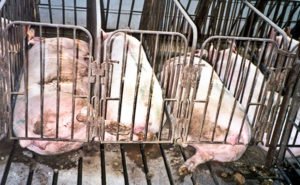 As babies, they are subjected to painful mutilations without anesthesia or pain relievers. At two to three weeks of age, the piglets are taken away from their mothers, by which time approximately 15% will have died. The surviving piglets are crowded into pens with metal bars and concrete floors.
As babies, they are subjected to painful mutilations without anesthesia or pain relievers. At two to three weeks of age, the piglets are taken away from their mothers, by which time approximately 15% will have died. The surviving piglets are crowded into pens with metal bars and concrete floors.
The mother is then re-impregnated; when she is no longer deemed a productive breeder, she is sent to slaughter.
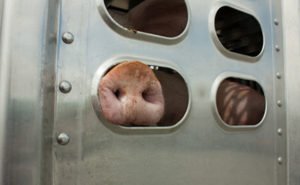
In addition to experiencing overcrowded housing, sows and pigs also experience crowding in transportation – despite the fact that this crowding causes suffering and deaths.
And then for the final act of injustice, the pigs experience a horrible death at the slaughterhouse where many are boiled alive.
For Meat
With a growing number of consumers switching from red meat to poultry, nearly ten billion chickens are being raised and killed for meat in the U.S. every year.
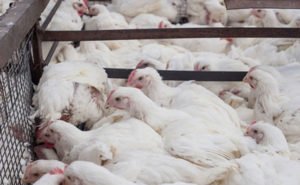 These birds are typically crowded by the thousands into huge factory-like warehouses where they can barely move – often only provided with six square inches of space per bird.
These birds are typically crowded by the thousands into huge factory-like warehouses where they can barely move – often only provided with six square inches of space per bird.
Today’s meat chickens have been genetically altered to grow twice as fast, and twice as large as their ancestors. Pushed beyond their biological limits, hundreds of millions of chickens die every year before reaching slaughter weight at six weeks of age. Broiler chickens now grow so rapidly that their heart and lungs are not developed well enough to support the remainder of their bodies, resulting in congestive heart failure and tremendous death losses.
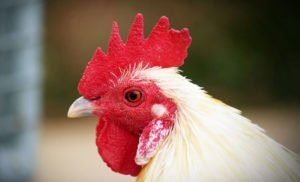 Once inside the slaughterhouse, fully conscious birds are hung by their feet from metal shackles on a moving rail. The birds’ heads are submerged in an electrified bath of water, called “stunning.” Since this procedure is not monitored, the birds are often still capable of feeling pain and are still conscious when they are slaughtered.
Once inside the slaughterhouse, fully conscious birds are hung by their feet from metal shackles on a moving rail. The birds’ heads are submerged in an electrified bath of water, called “stunning.” Since this procedure is not monitored, the birds are often still capable of feeling pain and are still conscious when they are slaughtered.
For Eggs
Approximately 300 million egg laying hens in the U.S. are confined in battery cages – small wire cages stacked in tiers and lined up in rows in huge warehouses. Four hens are packed into one cage just 16 inches wide. The birds cannot stretch their wings or legs, and they cannot fulfill normal behavioral patterns or social needs. Constantly rubbing against the wire cages, they suffer from severe feather loss, and their bodies are covered with bruises and abrasions.
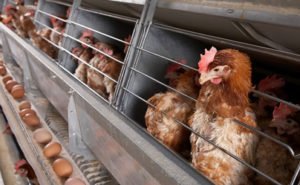 Practically all laying hens have part of their beaks cut off in order to reduce injuries resulting from excessive pecking. De-beaking is a painful procedure which involves cutting through bone, cartilage, and soft tissue.
Practically all laying hens have part of their beaks cut off in order to reduce injuries resulting from excessive pecking. De-beaking is a painful procedure which involves cutting through bone, cartilage, and soft tissue.
Laying more than 250 eggs per year each, laying hens’ bodies are severely taxed. They commonly suffer from infections and several diseases such as fatty liver syndrome, cage layer fatigue, osteporosis, cancers and other ailments.
After one year in egg production, the birds, are classified as ‘spent hens’, and sent off to slaughter. They usually end up in soups, pot pies, or similar low grade chicken meat products where their bodies can be shredded to hide the bruises from consumers. Spent hens often end up in animal feed.
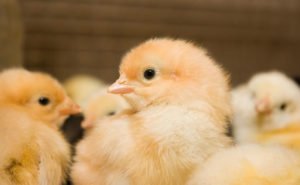 And for every egg laying hen confined in a battery cage, there is a male chick who was killed at the hatchery. Because egg laying chicken breeds have been selected exclusively for maximum egg producton, they don’t grow fast enough or large enough to be raised profitably for meat. Therefore, male chicks of egg laying breeds are of no economic value, and are literally discarded on the day they hatch – usually by the least expensive and most convenient means available (e.g., thrown into trash cans or ground up while alive).
And for every egg laying hen confined in a battery cage, there is a male chick who was killed at the hatchery. Because egg laying chicken breeds have been selected exclusively for maximum egg producton, they don’t grow fast enough or large enough to be raised profitably for meat. Therefore, male chicks of egg laying breeds are of no economic value, and are literally discarded on the day they hatch – usually by the least expensive and most convenient means available (e.g., thrown into trash cans or ground up while alive).
Half a billion turkeys are being hatched in the U.S. every year. These birds are typically crowded by the thousand into huge factory-like warehouses where they can barely move, given less than three square feet each.
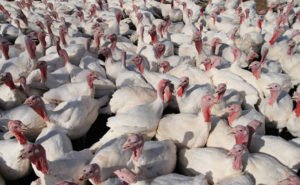 Turkeys have the end of their beaks cut off and their toes clipped. All of these mutilations are performed without anesthesia, and they are done in order to reduce injuries which result when stressed birds are driven to fighting.
Turkeys have the end of their beaks cut off and their toes clipped. All of these mutilations are performed without anesthesia, and they are done in order to reduce injuries which result when stressed birds are driven to fighting.
Like meat type chickens, commercial turkeys also suffer from genetic manipulation. In addition to having been altered to grow fast and large, commercial turkeys have been anatomically manipulated to have large breasts to meet consumer demand for breast meat. As a result, turkeys cannot mount and reproduce naturally, and so their sole means of reproduction is artificial insemination. Turkeys are also susceptible to heart disease, and their legs have difficulty supporting their overweight bodies.
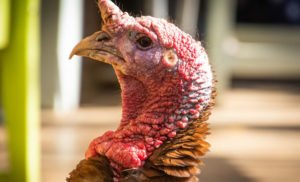
Once inside the slaughterhouse, fully conscious birds are hung by their feet from metal shackles on a moving rail. The first station on most poultry slaughterhouse assembly lines is the stunning tank, where the birds’ heads are submerged in an electrified bath of water. Although poultry is specifically excluded from the Humane Slaughter Act which requires stunning, the practice is common because it immobilizes the birds and expedites assembly line killing.
Stunning procedures are not monitored, and they are often inadequate. The birds are still capable of feeling pain, and often emerge from the stunning tank still conscious. After passing through the stunning tank, the birds’ throats are slashed, usually by a mechanical blade. Inevitably, the blade misses some birds who then proceed to the next station on the assembly line, the scalding tank. Here they are submerged in boiling hot water. Birds missed by the killing blade are boiled alive. This occurs so commonly, affecting millions of birds every year, that the industry refers to them as “redskins.”
Sheep
Approximately two million sheep and lambs are slaughtered for food in the U.S. every year.
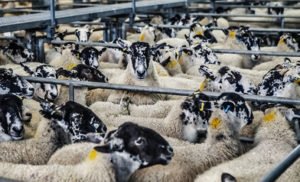
Also often confined into crowded lots and warehouses, sheep are subjected to stress, disease and mistreatment from the time they are born to the time they are slaughtered.
When the lambs are only a few weeks old, these sensitive and intelligent beings have their tails docked in order to prevent fecal matter from accumulating near their backside. This is a very painful procedure for the lambs that is done without anesthesia.
Then the sheep are usually subjected to crowded and inhumane conditions until they are old enough to transport for slaughter when they are very young, only between six to eight months old.
Ducks and Geese
Foie gras—French for “fatty liver”—is the grossly enlarged liver of a duck or goose. Medically known as hepatic lipidosis, foie gras is a disease marketed as a delicacy.
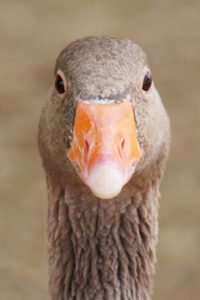
Foie gras is produced by force-feeding confined ducks or geese massive quantities of food, via a mechanized pump, several times a day. Young ducks or geese are confined inside dark sheds and have over four pounds of corn mush forced down their throats through a long metal pipe each day for two to three weeks until they can barely move and are on the verge of organ rupture and death.
This process of deliberate and painful overfeeding continues for up to a month, by which time the birds’ livers have swelled up to twelve times their healthy size. The birds are then slaughtered, and their livers are sold as “foie gras.”
France produces most of the world’s annual 10,000 tons of foie gras, but inhumane force-feeding also still occurs in U.S. factory farms in New York.
In 2004, a new law banned the process of making foie gras, and had been circulating throughout California courts for 15 years since. But in early 2019, the U.S. Supreme Court refused to hear arguments against
California’s foie gras ban. The Court’s action meant that, once again, no business may sell or produce foie gras in Los Angeles or within California.
Fish
Fish farming is one of the most intensive forms of animal agriculture. Farms typically put 50,000 to 90,000 fish in a pen 100 feet by 100 feet. A single farm can grow 400,000 fish; some raise a million or more, taking a huge toll on the environment. The costs of the growth of fish farms include coastal pollution, displacement of local people from their land, and the clearing of large tracts of coastal mangrove forests. Intensive man-made shrimp farms have been equally staggering.
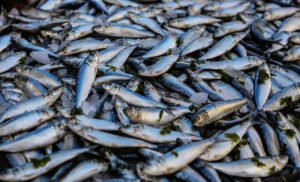 Disease and parasites run rampant in densely packed fish farms. Deadly sea lice infestation are common. Pesticides are fed to the fish and toxic copper sulphate is used to kill algae that build up on the nets. Antibiotics have created resistant strains of disease that infect both wild and domesticated fish.
Disease and parasites run rampant in densely packed fish farms. Deadly sea lice infestation are common. Pesticides are fed to the fish and toxic copper sulphate is used to kill algae that build up on the nets. Antibiotics have created resistant strains of disease that infect both wild and domesticated fish.
Of all the concerns, the biggest turns out to be a problem fish farms were supposed to alleviate: the depletion of marine life from over fishing. The fish farms contribute to the problem because the captive salmon must be fed. It takes about 2.4 pounds of wild fish to produce one pound of farmed salmon.
And the prospect of genetically modified salmon that can grow six times faster than normal fish has heightened anxiety. Critics fear that these “frankenfish” will escape and pose an even greater danger to native species.
Others
Rabbits, buffalo, emus, ostriches, turtles, sharks, wildlife, and even companion animals such as horses, dogs and cats. There is seemingly no end to the animals who suffer at the hands of humans who have decided to target them for food. If given an opportunity, these animals will run, fly or swim away and will fight to stay alive because their lives matter to them just as human lives matter to humans.
With so many delicious, healthy and nutritious plant-based meal options available today, it really makes zero sense to continue to subject sentient creatures to such cruel and abusive harm and death in order to end up on a dinner plate.
